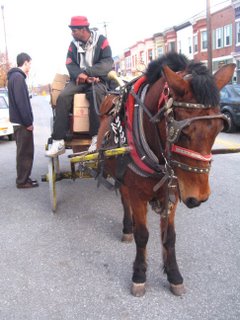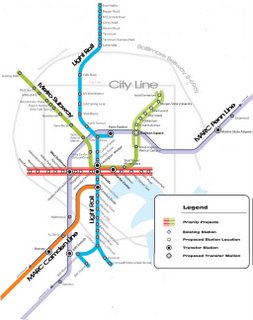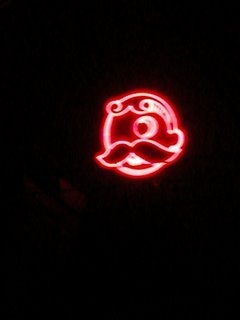 There are so many parochial facets of Baltimore that make this city's natives proud to call (c)Harm City home. The "o" in home is a long sort of "o," and there's a bit of a Hiberno-English or perhaps Cornish Enligh twang on the phoneme. All of you who are familiar with the highly particular "o" sounded in these parts will know of what I am speaking. While the accent and dialect of English spoken in Baltimore is similar to that spoken in and around Philadelphia, south Jersey, and up and down Delaware, the distinctly Baltimore accent is by far the most fascinating sort of mid-Atlantic English. Hyperbolic I am not, and you shall take a most pleasant trip to Highlandtown or Hampden to find out from where the mystique doth come.
There are so many parochial facets of Baltimore that make this city's natives proud to call (c)Harm City home. The "o" in home is a long sort of "o," and there's a bit of a Hiberno-English or perhaps Cornish Enligh twang on the phoneme. All of you who are familiar with the highly particular "o" sounded in these parts will know of what I am speaking. While the accent and dialect of English spoken in Baltimore is similar to that spoken in and around Philadelphia, south Jersey, and up and down Delaware, the distinctly Baltimore accent is by far the most fascinating sort of mid-Atlantic English. Hyperbolic I am not, and you shall take a most pleasant trip to Highlandtown or Hampden to find out from where the mystique doth come. In particular, the hamsters (Hampden hipsters) became enthralled so much by the accent most commonly found in Hampden that they began to flock to the neighborhood formerly inhabited exclusively by mill workers and other industrially-inclined folk whose ancestors migrated there from Appalachia. Though the neighborhood was in serious decline throughout the 80's and 90's, the urban locale is now one of the hottest areas in B-more. The main commercial artery of Hampden is known as the Avenue (36th st.), where a mix of true Hampdenites, hamsters, and assorted other Baltimorons roam the strip. Kitsch, schmaltz, and authentic indigenous crafts dot the landscape, but an uneasy feeling of invasion pervades. Is the old Baltimore reluctant to step aside, or can the two demographic segments coexist harmoniously? A-rabbers still parade their donkeys across the Avenue, peddling their produce to pedestrians while parroting paeans. And, Hampden plays host to a breed of urban dweller that is said to have missed the second half of the 20th Century.

The rudiments of Baltimore's unique flava are found in horrible haircuts, mispronounced consonants, and in the remarkably parochial citizenry who typically cannot name more than three neighborhoods outside of the one they inhabit. These attributes are beautiful, and don't let anyone tell you otherwise. Gentrificious, educated, and stodgy folks might lend human capital to their geographic niches, but the masses provide cities with a sense of tradition, a love of things that aren't so peachy, like stubborn murder rates and b-more club. However, don't let this laundry list convince you that Baltimore hasn't been well-served by its honorable mayor. Also, don't be deceived into thinking that I don't adore my native city (though I do in fact currently reside in the northwestern portion of the metropolitan region and not in the inner sector).
Lord O'Malley has indeed created a city that is more amenable for absorbing yuppies. Though this town ought not truthfully proclaim (as it does on omnipresent bus stop benches) that it's the Greatest City in America, this town has a lot going for it. One native, Spankrock, once said that Baltimore is the most under-rated party city in America. A budding anthropologist from Manhattan's Upper West Side once became so obsessed with both Dundalk and Hampden that he decided to excise his uptown Yankee demons and become baptized as a born again Baltimoron.
We got crabs, Berger cookies, and damn good police dramas abour our urban pharmaceutical industry. Stop Snitching, Babe Ruth, and Edgar Allan Poe all germinated in Baltimore. Long live Mr. Boh! How bout dem Ravens?

Me, I'm just impatiently waiting on the construction of two new mass transit lines: one, the Green, will be an extension to the NorthEast of the current Subway line that ends at Johns Hopkins Hospital; two, the Red, will run east-west from the Social Security Administration to Patterson Park, through downtown. These projects likely won't be completed til 2014 or so. We've got 1/3score to wait until Baltimore has a genuine public transit network. Citistat/Compstat may be able to pinpoint the locations of lead poisonings, waste removal, and property crimes, but it cannot provide sufficient impetus for an end to the tremendous favortism that city, state, and federal governments have exhibited for cars, highways, and sprawl. Enough is enough. Baltimore is back. JHU might be commandeering the Middle East community, but B-more is on the map now more than ever. After New York City, Baltimore was the 2nd city in the US to reach a population of 100,000. In fact, until 1870, Baltimore was indeed the 2nd most populous city in the nation. Rod Lee, show these knuckleheads what time it is!






No comments:
Post a Comment